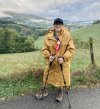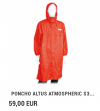I do not argue personal choices, which are a subjective thing. . . what someone likes is not arguable. Some folks like liver and onions, others hate both.
For the last decade, at least, I have found myself choosing a poncho for wet-weather walking. There are certain usability characteristics that I now prefer with ponchos. So I will point out some things that are objective considerations about the poncho. Again, there is no wrong choice because personal taste and preference is based around a huge number of variables, and every person has unique need and wants..
Altus and other similar sleeved hybrids of ponchos (rainchos?) can also share the some of the benefits of poncho use, but are generally heavier and bulkier, if that is an issue.
Ponchos that I would recommend are pretty lightweight. As an example, The Frogg Toggs when it is actually scaled, weighs around the 6 ounce mark. They can be had for $15.00 to $25.00, so that is a HUGE bargain for a highly functional piece of rain protective gear.
If I use my Zpacks poncho which is made from Dyneema (Cuben Fiber), it weighs just a bit more than 2.5 ounces and is tough as nails. I do like the Frogg Toggs a lot, though, and have used it quite a bit.
I find a poncho is more easily deployed. I can pull it out of the side pocket of my backpack and slip it on over my backpack, and I do not even have to stop. I usually
do pause for the ten seconds it takes to put on, because I am becoming a bit clumsy

I do not need to take my backpack off, put on a rain jacket, put the backpack back on.
This alone is a huge factor for me when it rains - as is often the case - it is off and on while walking. Periodic sprinkles and showers can eat up a lot of time and energy with a rain jacket IF you take it off and put it on as the immediate conditions change. There is no need to fiddle with rain covers on backpacks, and shoulder straps remain dry.
With a poncho, I can respond to conditions within seconds. I can whip off the poncho as soon as the rain has slowed or stopped, and not question "should I wait to see if it starts back up?" This helps to keep sweat condensation way down.
Air circulation and ventilation reduce condensation moisture build up, and this is helped along because of the poncho sitting over the backpack, creating air space between itself and the body.
A poncho can work equally as well, and even more flexibly, as an outer layer. The same quickness to deploy and remove a poncho works well in trying to avoid unexpected wind chill. And if the morning is cool as I start to walk, but I know I will be warm after a short walk, simply putting the poncho on for a few minutes and then whipping it off works well to avoid overheating.
On my poncho, I spend about 15 minutes after I purchase it and add a slight modification with cordage that controls flappiness and billowing during windy, stormy conditions.
On the aesthetics side, rain jackets do have the edge. . . depending on if form is a factor with regard to function.
And ponchos are great multitaskers:
- A shelter lean-to. A bit of cord and trekking poles make it even more independent in setting up.
- A sun shelter, it can be rigged up to provide you shade in hot climates.
- Ground cloth: Under a tent, or a survival shelter, a poncho can protect you from the damp ground. If you are in a cold damp climate, this can help you stay warm.
- Wind Break: A poncho without a liner will not have much insulation. However, as an outer shell, it can add an additional 10 to 20 degrees of warmth to whatever insulating layer you are wearing. You will stay warmer wearing the poncho in windy weather, helping to protect you from wind chill.
- Privacy: A great makeshift, emergency privacy screen when needing a Nature Break where a natural coverage of bushes or tall grass is scarce. It also works when needing to change pants or shorts.
- Sit pad. When taking a break and the ground and benches and flat rocks and logs, etc. are damp.
- Mattress cover.
- An emergency backpack or carryall when you do not have a small daypack.
- A windshell to add a bit of extra warmth to clothing layers. It is great for those cool, early mornings when you need something that can be quickly removed after you have warmed up from walking.






























